An investigation was conducted of the combined effect of salinity and temperature on growth, survival, and biomass productivity of postlarval and early juvenile pink shrimp Farfantepenaeus duorarum (Burkenroad 1939) produced from a single spawning event. The study used a factorial block design consisting of three salinity treatments (15, 35, and 55), each replicated, within three temperature treatment (22°C, 27°C, and 32°C) water baths. The study was divided into two phases: postlarval (first 28 days) and early juvenile (second 28 days). Growth was assessed every 7 days throughout the experiment by measuring carapace length (CL) and wet weight (WWT) of 15 randomly selected shrimp from each temperature/salinity replicate tank. After the first study phase, survival was assessed and experimental aquaria were reset with 30 randomly selected shrimp from the same temperature—salinity replicates. Survival was assessed again at the end of the early juvenile phase. The effect of treatments was evaluated by average growth (average finalWWT), survival, and average final biomass production. Exponential growth rates (CL andWWT) and temperature physiological coefficients (Q10) were also computed. Effects of temperature and salinity on growth and survival were variable, and no significant interaction among the treatment factors was observed. Biomass production increased consistently with temperature (postlarval, P > 0.0001; early juvenile, P < 0.0001) and decreased at the highest salinity (55; postlarval, P = 0.0140; early juvenile, P < 0.0001). Significant reductions in all performance outcomes except postlarval growth (P > 0.05) were observed at the high salinity of 55. The response of growth to salinity was not significant until the early juvenile treatment phase, whereas the effect of temperature on growth was significant during both phases. Hypersalinity (salinity, 55) had a detrimental effect on performance outcomes; however, performance outcomes at salinities of 15 and 35 were comparable. These results have implications for the natural productivity of pink shrimp in Florida Bay, where conditions are often hypersaline.
How to translate text using browser tools
1 December 2013
Influence of Temperature and Salinity on Growth, Survival, and Biomass Productivity of Postlarval and Early Juvenile Pink Shrimp Farfantepenaeus duorarum (Burkenroad 1939)
Ian C. Zink,
Maria M. Criales,
Joan A. Browder
ACCESS THE FULL ARTICLE

Journal of Shellfish Research
Vol. 32 • No. 3
December 2013
Vol. 32 • No. 3
December 2013
exponential growth rate
Farfantepenaeus duorarum
Florida Bay
hypersaline
penaeid
Q10
shrimp




